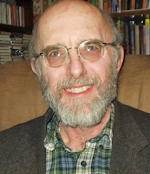MALIBU, CA—Irnee D’Haenens, a physicist who assisted Ted Maiman in making the first laser at Hughes Research Laboratory (Malibu, CA) in 1960, died December 24; he was 73. The two were the only people present when a little ruby rod emitted the world’s first pulse of laser light on May 16, 1960. The pulse was so intense that D’Haenens, normally color blind to red light, was able to see red for the first time. Later, D’Haenens called the laser “a solution looking for a problem”—a joke that became common in the early years of the laser era as developers sought laser applications.
Born in Mishawaka, IN, the son of a service–station operator, D’Haenens spent his entire professional career at Hughes, starting as a part–time assistant to Maiman while he was earning a masters degree from the University of Southern California. His first project was helping Maiman develop a compact ruby microwave maser, which Maiman eventually reduced to a four–pound package cooled by liquid nitrogen. He remained with Maiman as a full–time assistant after graduation as Maiman began investigating prospects for making a ruby laser.
Other researchers had said ruby emitted light too inefficiently for use in a laser. But when Maiman and D’Haenens measured ruby emission, they found it was extremely efficient. Maiman then calculated that bright pulses from a flashlamp should produce a population inversion, and designed a compact laser with a fingertip–sized ruby rod slipped into a coiled photographer’s flashlamp. The two tested the device by gradually cranking up the voltage applied to the lamp and measuring the changes in ruby emission on an oscilloscope screen. When the voltage passed 950 volts, the pulse shape changed to laser emission, the light brightened, and the exuberant D’Haenens jumped for joy.
Bright, easy–going, and affable, D’Haenens remained at Hughes after Maiman left, working on an optically pumped microwave maser and other laser development. In 1963, he received a Hughes doctoral fellowship and earned his PhD from the University of Notre Dame in 1966. As a member of the technical staff at Hughes, he worked on semiconductor physics, microwave technology, and spectroscopy as well as lasers before retiring in 1989. A long–time Hughes colleague, David Pepper, recalled D’Haenens as “as a wise and learned uncle who helped me travel along my path in life,” whose first priority was always his family. He is survived by his wife Shirley, four children, 19 grandchildren, and three great–grandchildren.

Jeff Hecht | Contributing Editor
Jeff Hecht is a regular contributing editor to Laser Focus World and has been covering the laser industry for 35 years. A prolific book author, Jeff's published works include “Understanding Fiber Optics,” “Understanding Lasers,” “The Laser Guidebook,” and “Beam Weapons: The Next Arms Race.” He also has written books on the histories of lasers and fiber optics, including “City of Light: The Story of Fiber Optics,” and “Beam: The Race to Make the Laser.” Find out more at jeffhecht.com.